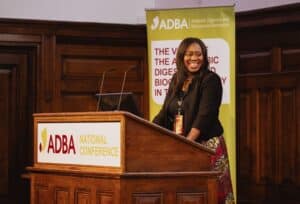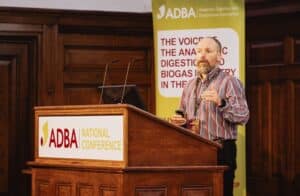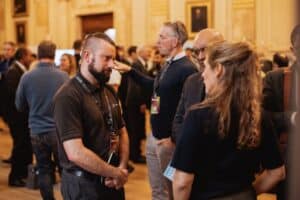Lord Alan Whitehead’s appointment as Minister of State at the Department for Energy Security and…
ADBA National Conference 2024 – Key takeaways
ADBA National Conference 2024 – Key takeaways
By Dr Gareth Mottram, Policy Lead, ADBA
On the new government’s vision
 Miatta Fahnbulleh MP, Parliamentary Under-Secretary of State at the Department for Energy Security and Net Zero, provided a fantastic keynote speech for the conference, explicitly proclaiming that the biogas/biomethane industry is an indispensable part of the green energy transition mission of the new government. She called out the contribution to reduce energy uncertainty and remove fossil carbon from the energy system that the biogas world provides. This was an incredibly positive message from a very impressive minister.
Miatta Fahnbulleh MP, Parliamentary Under-Secretary of State at the Department for Energy Security and Net Zero, provided a fantastic keynote speech for the conference, explicitly proclaiming that the biogas/biomethane industry is an indispensable part of the green energy transition mission of the new government. She called out the contribution to reduce energy uncertainty and remove fossil carbon from the energy system that the biogas world provides. This was an incredibly positive message from a very impressive minister.
 We were lucky enough to get an extended Q&A session with Ms Fahnbulleh, in which she was pushed on the end of the RoC/FiT schemes and the unfair coverage of biomethane in the ETS. She dealt with both questions in good humour and expressed interest in resolving them to achieve the green transition quickly, fairly and reliably. This was, in short, an extremely encouraging way to start the day.
We were lucky enough to get an extended Q&A session with Ms Fahnbulleh, in which she was pushed on the end of the RoC/FiT schemes and the unfair coverage of biomethane in the ETS. She dealt with both questions in good humour and expressed interest in resolving them to achieve the green transition quickly, fairly and reliably. This was, in short, an extremely encouraging way to start the day.
On the Green Gas and Net Zero report and the future of the gas grid
 The conference opened with our launch of the new modelling report “The Role of Green Gas in Net Zero“, produced by ADBA in conjunction with BMA on the use of biomethane in the UK energy system, which describes how using the biogas sector holistically can deliver a cheaper, faster and probably deeper decarbonisation of the UK energy system, not just the electricity or gas by all energy uses. This report was well received and we look forward to working through it with a range of government and NGO stakeholders in the new year.
The conference opened with our launch of the new modelling report “The Role of Green Gas in Net Zero“, produced by ADBA in conjunction with BMA on the use of biomethane in the UK energy system, which describes how using the biogas sector holistically can deliver a cheaper, faster and probably deeper decarbonisation of the UK energy system, not just the electricity or gas by all energy uses. This report was well received and we look forward to working through it with a range of government and NGO stakeholders in the new year.
We clearly heard about the capacity of the gas grid to store and transmit 2-3x the energy of the electricity grid, and to store up to 20% of that demand without needing dedicated storage. We have a national treasure in the form of 260,000km of infrastructure feeding 23,000,000 customers across all sectors. This is an infrastructure project that is probably not replicable in the modern world and should not be undervalued. We also heard how the policy landscape shapes what is delivered, in the absence of a clear biomethane target the UK has begun to lag significantly behind France, which has a clear target of 44TWh of biomethane in the gas system by 2030.
On the financing of plants
The financing of plants to achieve these goals was discussed in the session led by Michael Ware of Green Giraffe Advisory. He explained how the European plant numbers and capacity are growing “exponentially”, with Italy representing the hottest market. For corporate investors, biogas represents an easy sell, because it can add a ready-made “green” component to portfolios. Whilst this is positive, it is complicated by the multiple dimensions of uncertainty that come with producing biogas. These uncertainties being transportation economic of both feedstocks and resulting gases, the diversity of technology and techniques within the biogas sector, the short supply of expert understanding of operations and the value of renewable gas certificate prices.
Several solutions were discussed, to boost value with proven technologies, establish long term contracts for both feedstock and offtake, gaining permissions and capacity to expand amongst others. Ultimately, Michael emphasised the value of price certainty either from policy or guaranteed long term offtake agreements.
On AD and farming
The NFU chief climate advisor, Dr Jonathan Scurlock, albeit forced to present remotely at the last minute by family commitments, did a great job laying out how anaerobic digestion systems help fit in with farming process and should not be seen as either/or options. Prof. Peter Hammond of Ccm Technologies picked up the baton on this and relayed their experience of converting digestate into pelletised fertiliser much more familiar to most farmers. This represents the symbiosis of the technology, renewable energy and farming industries – something we must never lose sight of.
On the future of food waste feedstocks
The session on the future of food waste feedstocks established that there is still a lot of food waste to access, with only 50% of local authorities so far offering weekly food waste collections. Even within this, there is a low rate of capture. Many among the panel were concerned that there is not enough staff time available in municipal waste teams, which have seen a contraction of between 15% and 50% in the last 20 years.
We are all excited that the requirement to separate food waste is being phased in, but it is likely that this will take time to have a large effect on the feedstock situation. Contracts need to be established; old co-mingled waste contracts bring derogations, which will need to expire before the full value of the food waste stream can be realised. That said, there are signs of improvement, and the industry does have the capacity to cope with the anticipated volumes for the next few years. Food waste is turning into a slow-moving good news story after several years of difficulty. The last key point was that whilst there is the capacity to cope with the initial increased food waste supply, that capacity is not evenly distributed so there will need to be some more investment to ensure the greatest benefit comes from the increased feedstock over time.
On innovation
The innovation session focussed on the small-scale end of biogas, with exciting technology and research developments presented. According to Dr Thomas Fudge, the electro-enhanced anaerobic digestion system from WASE can offer shorter residence times and greater yields on small sites such as micro-breweries and farms. Prof. Penny Atkins of IFEAA helped provide a great justification for small scale operations showing research that demonstrated our general underestimation of fugitive emissions from existing manure management techniques. Agriculture represents 48% of our methane emissions and as we all know methane is over 80 times more potent as a greenhouse gas on a 20-year time frame, we only have 25 years to 2050. We heard from Louise Parlons Bentata about the saturated methane recovery system from Bluemethane. Recovering missed potential from digestate and wastewater is an interesting opportunity and deeply appropriate to as session dealing with the uncertainties around small and diverse sources of methane.
 Finally, if my day is anything to judge by the networking aspect of the conference, it was incredibly successful. It felt like there was a real buzz around biogas and our potential to move the needle on defossilisation of energy, energy security and environmental services.
Finally, if my day is anything to judge by the networking aspect of the conference, it was incredibly successful. It felt like there was a real buzz around biogas and our potential to move the needle on defossilisation of energy, energy security and environmental services.
